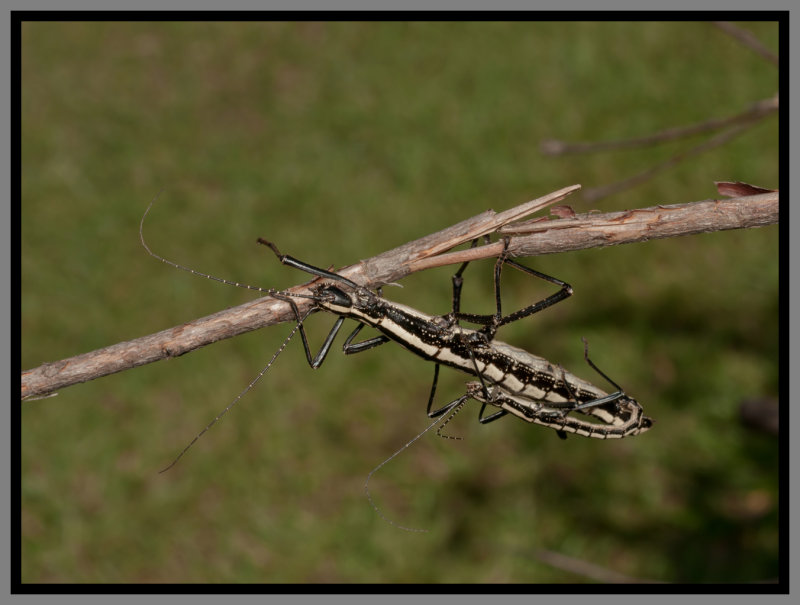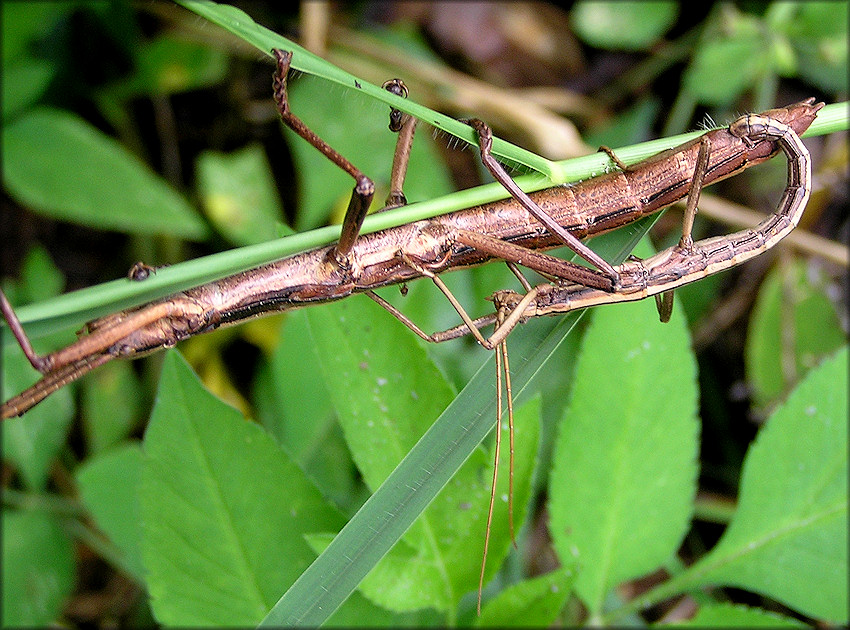Reproduction

All three color forms of Anisomorpha buprestoides exhibit similar
behavior while mating. They all engage in sexual reproduction,
during which a male and female produce haploid gametes via
meiosis
that fuse to form diploid zygotes. The zygotes grow through
mitosis inside of eggs, which the female lays. In this species
of walking sticks, though, copulation takes place in a slightly
different manner than in most organisms. Because the females are
so large, they actually carry the smaller males on their backs as they
rest, travel, and go through their daily routines. This
arrangement allows the walking sticks to copulate conveniently, often
for up to three weeks at a time (Sharp 2014). It is incredibly
common to find adult two-striped walking sticks in pairs, with the
male using his claws to cling dorsally to the female. The pairs
almost always stay this way, even when they are not engaging in
copulation. Add that to the scarcity of females in proportion to
the number of male walking sticks, and an adult female is nearly never
seen alone (Blackenhorn 2005).
To humans, this ritual may seem a bit strange. In our society, men are, on average, taller and stronger than women owing to the differences in the way human male and female bodies are built. In fact, most birds and mammals function the same way. However in A. buprestoides, the females are built with thicker bodies and additional length, giving them strength to carry the males. From an evolutionary standpoint, it is likely that the larger females evolved because they can carry more eggs and successfully produce more offspring (Blanckenhorn 2005). The males, on the other hand, gain no advantage by being larger. They instead must be the first to reach maturity and snatch a female mate quicker than the next male (Blanckenhorn 2005).
Similarly, the lengthy mating of two-striped walking sticks might
also seem odd. In an article speculating the advantages and
disadvantages of their long-term mating, D. T. Gwynne points out that
is has often been assumed that mating couples are at greater risk of
attack than those performing other activities (Gwynne 1989).
During copulation, the organisms might be less aware of potential
predators and less able to make a quick getaway once an enemy advances
(Gwynne 1989). Furthermore, mating expends large amounts of
energy. With these costly disadvantages to such a lengthy period
of copulation, one might wonder why A. buprestoides continues to mate
this way.

Several scientists have wondered about this as well and set up experiments to determine an answer. Perhaps not too surprisingly, they found that mating actually provides an advantage for this species, adequately explaining the long length of time it spends in copulation (Gwynne 1989). The most likely reason for the results is that a male and female together means twice the amount of their unique chemical defense spray and two insects with incredibly accurate aiming abilities instead of one. Therefore, predators probably are more wary of a pair of A. buprestoides, as it is more threatening than just one on its own.
Though all three color forms engage in the same near-constant coupling, they again demonstrate variation in their behavior for laying eggs. The brown form female, usually found in pine or oak woods, tends to simply drop her eggs from the tree branch she and her partner are perched on (Conle et al. 2009). The eggs then fall to the ground, where they will remain until they hatch. The white and orange forms, on the other hand, perform oviposition, which involves burying their eggs, a method that expends more time and energy but also better incubates the eggs and provides them with better protection from predators, including birds, rodents, and ants (Conle et al. 2009). These females, still carrying their males, search the sand for a decent location and dig a pit using their front and middle legs (Conle et al. 2009). Once the pit is finished, the female curls her abdomen upward over her head and drops her eggs, one at a time. Usually, she will lay five to ten eggs in a pit, and she might make two or three pits in a day (Conle et al. 2009). After the eggs are dropped, she covers them with sand and moves on to a new location.
The eggs are small, about 3 mm by 2 mm, and resemble the seeds of the walking stick’s food source. They have a rough and ridged texture, a gray, brown, or black color, often with spots, and a lid-like operculum structure at one end (Allred 1986). Usually the eggs are layed in the fall, when A. buprestoides is most abundant, and undergo a process called diapause, so they will not hatch until the spring. When they do, a young walking stick called a nymph emerges from the egg via the operculum (Allred 1986). The nymphs are normally brown but mostly resemble their parents. From there, A. buprestoides has a hemimetabolus life cycle, meaning the nymph goes through a series of molting stages, or instars, as it grows (Phasmatodea 2014). The nymph takes about three to five months to reach adulthood (Phasmatodea 2014).